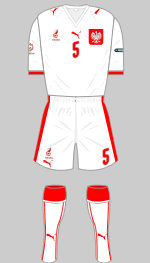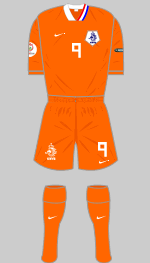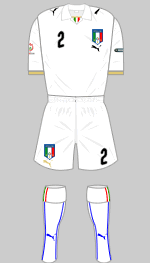Euro 2008
7th - 29 June 2008
 The 2008 UEFA European Football Championship (Fussball-Europameisterschaft 2008) also known as Euro 2008, hosted by Switzerland and Austria, takes place over last three weeks of June 2008. This is the second time that the tournament has been hosted by two federations, Belgium and the Netherlands having organised the 2000 competition together. Sixteen national sides will compete for the title of European Champions and a brand new version of the Henri Delauney Trophy. Austria and Switzerland qualified automatically as hosts while the remaining fourteen nations came through a qualifying competition that started one month after the 2006 World Cup finals and involved 50 countries.
The 2008 UEFA European Football Championship (Fussball-Europameisterschaft 2008) also known as Euro 2008, hosted by Switzerland and Austria, takes place over last three weeks of June 2008. This is the second time that the tournament has been hosted by two federations, Belgium and the Netherlands having organised the 2000 competition together. Sixteen national sides will compete for the title of European Champions and a brand new version of the Henri Delauney Trophy. Austria and Switzerland qualified automatically as hosts while the remaining fourteen nations came through a qualifying competition that started one month after the 2006 World Cup finals and involved 50 countries.
Notable by their absence are the five associations from the British Isles. While England's notorious supporters will not be missed by the Swiss and Austrian authorities, the tournament be less colourful without the travelling Irish and Scottish fans. Co-host Austria are making their first appearance in the final stages as are Poland, who, along with the Ukraine, will jointly host the next tournament in 2012.
Each national association is required to register their first and second choice of kit with UEFA in advance of the tournament. The second choice (or change) kit must be not only a distinctively different colour but provide a high degree of contrast. That is to say that if the first choice features dark shirts, the second choice should be pale: having said that, the French second kit simply swaps red for blue and vice versa. Change kits are often reversed versions of the first choice in the same national colours but several variations are used in order to comply with the regulations. Sponsorship is not permitted on kits although manufacturers' logos are allowed, their size and location being strictly regulated.
The teams are presented here in the order in which they were seeded in each of the four groups.
Group A (Basel/Geneva)
 Switzerland
Switzerland

First

Second

Alternate
Designer: Puma
Switzerland retain their traditional outfit of red shirts and stockings with white shorts, designed by Puma using a template introduced for this competition. The change kit is basically a reversed version but with some variation in the detailing. This is the third time the Swiss have featured in the finals. All four teams in Group A wear predominantly red shirts.
The Swiss wore their all-red alternate strip against the Czech Republic and Portugal.
 Czech Republic
Czech Republic

First

Second

Alternate
Designer: Puma
The Czech Republic's kits are very similar to those of the Swiss team with the addition of blue trim on the shirt and blue stockings. Since the break up of Czechoslovakia in 1994, the Czechs have appeared in two European championships (1996 and 2004) and are currently ranked sixth in the world. Between 1903 and 1908, the Czech national side played as Bohemia, then part of the Austro-Hungarian Empire.
The Czechs wore all-red in their match with Portugal and all-white in their other group matches.
 Portugal
Portugal

First

Second
Designer: Nike
After several years playing in dark red shirts, Portugal have returned to a more traditional shade with subtle green trimmings. The second choice kit simply replaces red with white. Both kits typify Nike's approach of simplicity and sleek design.
Portugal wore their change kit against the czech Republic and Switzerland.
 Turkey
Turkey

First

Second

Alternate
Designer: Turkey
Turkey's new kit features a welcome return of the distinctive chest band that has been a traditional feature of their playing kits going back to 1923, when the national side played its first international but which has been missing in recent years. The change kit is something of a departure, as it does not feature the national colours at all (aside from the Turkish flag worn on the shirt.)
Turkey wore their second choice kit against the Swiss and against Portugal, they turned out in all-white.
Group B (Vienna/Klagenfurt)
 Austria
Austria

First

Second

Alternate
Designer: Puma
Austria have traditionally played in white shirts and black shorts and it is something of a mystery why they have opted for red and white (usually their second choice of kit) for this, their first ever appearance in the European Championship. As a result, both co-hosts will play in almost identical kits. The change kit is a rather more adventurous affair in black with metallic-gold trim.
The played in all-red against Poland.
 Croatia
Croatia

First

Home
Designer: Nike
Since Croatia's independence from Yugoslavia was recognised by the international community in 1991, the distinctive checkered shirts of the national team have become universally recognised and respected. As England discovered to their cost during the qualifying tournament, the Croats are a formidable side on home territory where they remain undefeated in competitive matches. This will be their third appearance in the European Championship.
The Croats played in all-blue in all of their matches.
 Germany
Germany

First

Second
Designer: Adidas
Germany's record in international competition is formidable. They have been finalists five times since they first entered the European Championship in 1970 and champions three times (1972, 1980 and 1996), an achievement marked by the three gold stars embroidered above their badge. Their new first choice kit is an elegant creation by Adidas, with the black chest band complemented by subtle red and gold bands to echo the national flag. The rather odd second choice kit is not so successful and was not used.
 Poland
Poland

First

Second

Alternate
Designer: Puma
Poland's traditional kit of white tops and red shorts effectively recreates their national flag and is instantly recognisable. The second choice is, however, yet another standard Puma template with little to distinguish it from all the other red over white outfits that feature in Euro 2008. The kits do feature a graphic featuring a stylised football above the word Polska ("Poland") as well as the traditional Polish eagle crest. This is the first time that Poland have reached the European Championship finals.
In the match with Austria, Poland wore all-white while the hosts were in all-red. For the match against Germany, Poland wore their second choice outfit.
Group C (Zurich/Berne)
 Netherlands
Netherlands

First

Second

Alternate
Designer: Nike
The Netherlands has a proud footballing heritage going back to the total football era of the 1970s but they have often failed at the last hurdle. Their one trophy came in 1988 when they won the European Championship. The Dutch play in bright orange, a colour that comes from the coat of arms of the William I of Orange, who led the revolt against Spanish rule that created the Dutch Republic in 1581. The modern tricolour is, however, represented by a flash on the collar. For the first time the team's kit feature's blue stockings, described as "Nassau Blue." This provides the dominant colour for their second choice of kit and is associated with the current Dutch royal family, the House of Orange-Nassau.
The Dutch wore all-orange in their final group match against Romania and against Russia in the quarter-final.
 Italy
Italy

First

Second

Alternate
Designer: Puma
Like the Netherlands, the Italian team plays in the colour of the royal house that created the first unified nation state, in this case Azzuro Savoia (Savoy Blue) after the royal House of Savoy. Italy's kits generally reflect the same design philosophy as the Italians bring to their clothes and cars - elegance, simplicity and sophistication. The all-blue first choice kit is embellished with metallic gold trim and a discrete tricolour flash on the stockings. The second choice kit features a small tricolour woven into the collar. Italy are by tradition one of the strongest sides in the world, with four World Cups to their name, but they have won the European Championship only once, in 1968.
Italy wore all-white in the group match against France and again in the quarter final against Spain.
 Romania
Romania

First

Second
Designer: Adidas
The Romanians may be regarded as the weakest team in this extremely strong group (inevitably dubbed "the group of death" by sports media unable to avoid a cliche) but they are a formidable team. Since the fall of the Ceaucescu regime in 1989, Romanian teams have usually played in all-yellow and the current side is no exception.
Romania wore their white kit against the Netherlands.
 France
France

First

Second

Alternate
Designer: Adidas
The French have enjoyed unprecedented success at international level in the last decade, winning the World Cup in 1998, the European Championship two years later and reaching the final of the World Cup in 2006. Their kits invariably follow the classic pattern of blue shirts, white shorts and red stockings and have been made by Adidas since the 1970s. For Euro 2008 the shirt features an elegant red swirl to create one of the more original and interesting kits of the tournament. The second choice kit reverses the main colours and is a departure from their usual choice of all-white.
France curiously wore all blue in their three group matches rather than their registered kits.
Group D (Innsbruck/Salzburg)
 Greece
Greece

First

Second
Designer: Adidas
Greece were surprise winners of the 2004 European Tournament having started as 150-1 outsiders. Since then, the team has continued to use the white kit used in the final as their first choice, retaining all-blue as their second choice. (Previously Greek teams usually played in blue). There is not much to say about their unimaginative Euro 2008 kit, a basic Adidas template but the all-blue change kit features a shadow stripe, recreating the Greek flag but it was not used.
 Sweden
Sweden

First

Second
Designer: Umbro
Sweden's kit, manufactured by the UK based Umbro company, is the only one appearing in the tournament that is not made by the global sportswear giants, Nike, Adidas and Puma. The first choice kit follows Sweden's traditional pattern but the second choice outfit, in dark blue, is rather different to their usual mid-blue.
 Spain
Spain

First

Second
Designer: Adidas
The Spanish are Europe's perpetual under-achievers and while they regularly appear in both the World Cup and European Championship final stages, they have only once won an international trophy, the European championship in 1964. Spain's traditional colours are red shirts with blue shorts, usually with gold trim. Currently the shorts are a dark navy shade and embellished with the national flag. The second choice kit features a metallic gold inset and, unusually, is worn with the first choice shorts and stockings. The FEF motif on the socks is derived from the badge of the Royal Spanish Football Association, Real Federacion Espanola de Futbol.
 Russia
Russia

First

Second
Designer: Nike
The Russian team are considered by both FIFA and UEFA to be the successors of the USSR and CIS teams of the past but since the break-up of the Soviet Union in 1991, they have competed as Russia and worn all-white, currently embellished with the horizontal tricolour flag of the Russian Federation. The flag has a fine gold edge in order to differentiate it from the background of the shirt.
 The 2008 UEFA European Football Championship (Fussball-Europameisterschaft 2008) also known as Euro 2008, hosted by Switzerland and Austria, takes place over last three weeks of June 2008. This is the second time that the tournament has been hosted by two federations, Belgium and the Netherlands having organised the 2000 competition together. Sixteen national sides will compete for the title of European Champions and a brand new version of the Henri Delauney Trophy. Austria and Switzerland qualified automatically as hosts while the remaining fourteen nations came through a qualifying competition that started one month after the 2006 World Cup finals and involved 50 countries.
The 2008 UEFA European Football Championship (Fussball-Europameisterschaft 2008) also known as Euro 2008, hosted by Switzerland and Austria, takes place over last three weeks of June 2008. This is the second time that the tournament has been hosted by two federations, Belgium and the Netherlands having organised the 2000 competition together. Sixteen national sides will compete for the title of European Champions and a brand new version of the Henri Delauney Trophy. Austria and Switzerland qualified automatically as hosts while the remaining fourteen nations came through a qualifying competition that started one month after the 2006 World Cup finals and involved 50 countries. Switzerland
Switzerland 


 Czech Republic
Czech Republic 


 Portugal
Portugal

 Turkey
Turkey


 Austria
Austria


 Croatia
Croatia

 Germany
Germany

 Poland
Poland


 Netherlands
Netherlands


 Italy
Italy


 Romania
Romania

 France
France


 Greece
Greece

 Sweden
Sweden

 Spain
Spain

 Russia
Russia
